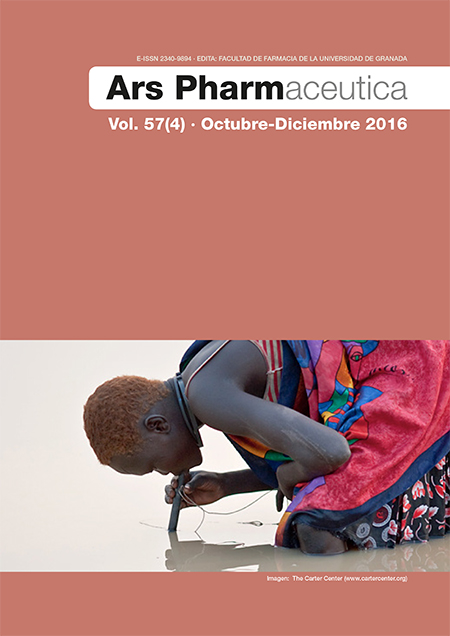First experiences of monitoring of vancomycin in a General Hospital of Specialties
DOI:
https://doi.org/10.30827/ars.v57i4.5558Keywords:
vancomycin, monitoring, clinical pharmacokineticsAbstract
Introduction: vancomycin is an effective antibiotic for the treatment of infections due to Gram-positive germs, however renal toxicity associated with its use, has relegated its use to use secondary lines. This fact has consolidated the empirical treatment with more expensive antibiotics.
Objective: to analyze the data of monitoring of vancomycin and rating the efficiency facing the use of other antibiotics.
Materials and methods: observational study where discusses monitoring pharmacokinetics of Vancomycin and a unit of pharmacokinetics clinical efficiency, with a population of 137 patients admitted to a general hospital specialties.
Results: the use of Vancomycin in first intention meant a savings of € 16.472,82 regarding the use of € 83.039,83 the linezolid and daptomycin. However, 18% of our sample not could be treated with Vancomycin, making it necessary to have other drugs.
Downloads
References
Walsh T, Howe RA. The prevalence and mechanisms of vancomycin resistance in Staphylococcus aureus. Annu Rev Microbiol 2002; 56:657-75.
Lowy FD. Antimicrobial Resistance: the example of Staphylococcus aureus. The Journal of Clinical Investigation 2003; 111(9):1265-73.
Elyasi S, Khalili H, Dashti-Khavidaki S, Mohammadpour A. Vancomycin-induced nephrotoxicity: mechanism, incidence, risk factors and special populations. A literature review. Eur J Clin Pharmacol. 2012; 68(9):1243–55.
Weston A, Golan Y, Holcroft C, Snydman DR. The efficacy of daptomycin versus vancomycin for methicillin-resistant Staphylococcus aureus bloodstream infection in patients with impaired renal function.
Clin Infect Dis. 2014; 58(11):1533-1539.
Stephen Y. Lianga, Hani N. Khaira, Jay R. McDonalda,b, Hilary M. Babcocka, and Jonas Marschall. Daptomycin vs. vancomycin for osteoarticular infections due to methicillin-resistant Staphylococcus aureus (MRSA): A nested case-control study. Eur J Clin Microbiol Infect Dis. 2014; 33(4): 659–664.
Kim HB, Lee YS, Kim BS, Cha JO, Kwon SU, Lee HJ, Suh JT, Rheem I, Kim JM, Shin BM, Kim MN, Lee K, Lee CS, Kim EC, Oh MD, Choe KW. Prevalence and clinical implications of Staphylococcus aureus with a vancomycin MIC of 4 microg/ml in Korea. Microb Drug Resist 2006; 12(1):33-8.
Appelbaum PC. The emergence of vancomycin-intermediate and vancomycinresistant Staphylococcus aureus. Clin Microbiol Infect 2006; 12(1):16-23.
Goldstein FW, Kitzis MD. Vancomycin-resistant Staphylococcus aureus: no apocalypse now. Clin Microbiol Infect 2003; 9:761-5.
Rybak MJ, Akins RL. Emergence of methicillin-resistant Staphylococcus aureus with intermediate glycopeptide resistance: clinical significance and treatment options. Drugs 2001; 61(1):1-7.
Downloads
Published
How to Cite
Issue
Section
License
The articles, which are published in this journal, are subject to the following terms in relation to the rights of patrimonial or exploitation:
- The authors will keep their copyright and guarantee to the journal the right of first publication of their work, which will be distributed with a Creative Commons BY-NC-SA 4.0 license that allows third parties to reuse the work whenever its author, quote the original source and do not make commercial use of it.
b. The authors may adopt other non-exclusive licensing agreements for the distribution of the published version of the work (e.g., deposit it in an institutional telematic file or publish it in a monographic volume) provided that the original source of its publication is indicated.
c. Authors are allowed and advised to disseminate their work through the Internet (e.g. in institutional repositories or on their website) before and during the submission process, which can produce interesting exchanges and increase citations of the published work. (See The effect of open access).























